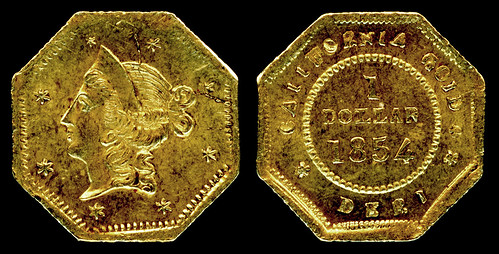
PREV ARTICLE
NEXT ARTICLE
FULL ISSUE
PREV FULL ISSUE
NEW CALIFORNIA FRACTIONAL GOLD VARIETYDiscovering a new variety in a long-studied series is always an exciting development in numismatics. This press release from Stack's Bowers describes an interesting new die pairing in the California fractional gold series. "BG" stands for Breen-Gillio, California Pioneer Fractional Gold, the standard reference for Fractional Gold by Walter Breen and Ron Gillio. -Editor New 1854 Period 1 California Fractional Gold Dollar Variety Discovered A new die variety of California Fractional Gold Dollar has been discovered by Ken Glickman, an avid collector and researcher of California Fractional Gold for more than two decades. The new variety has been confirmed by California Fractional Gold specialists Ronald J. Gillio, Robert D. Leonard, Jr. and John Pack. The new variety designation for this unique specimen will be listed as BG-526a, as that comes between BG-526 (1853) and BG-527 (1854) in the BG reference book. The new specimen's obverse is the same as that of BG-526, and is easy to match, as follows: There are three prominent die cracks (one above the portrait, connecting the head to the rim, and two near 3 o'clock, connecting the upper and lower portions of the hair bun to the rim). The bold nature of these breaks makes them easy to identify. Since they are heavier in this pairing than seen in the BG-526 usage, they must always be present in this marriage. The reverse die differs from that used for BG-526, however, and has been determined to match the die used to strike the unique BG-529, but in an earlier state. Hence, a new die pairing is discovered! Interestingly, this muling of the BG-526 obverse and BG-529 reverse combines an obverse used in an 1853-dated pairing and a reverse used in an 1854-dated pairing. It also sheds light on the striking sequence of these varieties by way of comparison of the die states. There is notable difference in the thickness of the three die cracks between BG-526 (minted in 1853) and the new variety (minted in 1854). BG-526 is reportedly known in two die states, one with faint cracks and one with heavier ones. These cracks in the BG-526a usage are further advanced, placing the BG-526a in sequence as the later usage. The dramatic advancement of these breaks, their significant size, and the fact that this variety wasn't discovered until well into the 21st century is complementary evidence suggesting that the obverse likely failed completely not long after this piece was struck. It is the only known specimen thus far, and it could well be unique.
Ken Glickman stated:
Expert Robert D. Leonard, Jr. commented:
Specialist Ron Gillio of Stack's Bowers Galleries added:
THE BOOK BAZARREWayne Homren, Editor The Numismatic Bibliomania Society is a non-profit organization promoting numismatic literature. See our web site at coinbooks.org. To submit items for publication in The E-Sylum, write to the Editor at this address: whomren@gmail.com To subscribe go to: https://my.binhost.com/lists/listinfo/esylum All Rights Reserved. NBS Home Page Contact the NBS webmaster 
|
